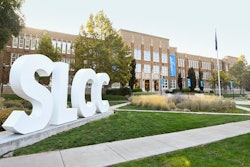Losing Ground
Proportional declines mar engineering education picture for underrepresented minorities.
BY RONALD ROACH
After more than a decade of steady enrollments and degree completion rates by underrepresented minorities, public schools, colleges, advocacy groups and government agencies still face a daunting task in helping bring Blacks, Latinos and American Indians into the engineering profession in numbers reflecting their growing ranks in the American population.
“The minority fraction of the (American) student population is growing, so absolute growth in numbers of enrollees and graduates represent a smaller fraction of the total. For example, 2003 baccalaureate degrees rose almost 10 percent (from the previous year) in engineering, but African American, Latino, American Indian and women experienced fractional declines. Only Asians and foreign nationals grew in percentage terms,” says Dr. Darryl Chubin, the senior vice president for policy and research at the National Action Council for Minorities in Engineering Inc. (NACME).
In a 2003 report titled, “Walking the Talk in Retention-to-Graduation: Institutional Production of Minority Engineers — A NACME Analysis,” Chubin and co-author Eleanor Babco, executive director of the Washington-based Commission on Professionals in Science and Technology (CPST), document the engineering education lag by underrepresented minorities and women. Among enrolling students, the “absolute numbers have been increasing for both women and underrepresented minority engineering freshmen,” yet “the numbers for men and non-minority freshmen have been increasing at a faster pace,” according to Chubin and Babco.
“In 1995, women represented 19.9 percent of the freshman class; in 2001, they represented 18.3 percent. In 1995, underrepresented minorities constituted 17.4 percent of the freshman engineering class; in 2001, they represented 15.8 percent,” the report says.
The picture for underrepresented minorities has both educators and policy-makers worried over whether engineering schools can attract and retain Black, Latino and American Indian students at a rate consistent with their growth in the larger student population. The coming demographic shift that’s expected to make the United States a non-White majority nation around the year 2050 has made engineering and science education a high priority among policy-makers, scholars and educators. Experts say the long-term prospects for a competitive national economy depend on boosting the participation of underrepresented students in the sciences and engineering.
Complicating the task is the difficulty of attracting Americans into science and technology. Chubin says that despite American society’s growing reliance on scientific expertise and technology, the percentage of college-bound high-school graduates pursuing engineering careers has consistently ranged around 9 percent over the past 30 years. He adds that just 6 percent of college-bound high-school students have pursued science degrees.
“You’d expect more (American-born) students in those areas given society’s increasing dependency on scientific and technological expertise. But you don’t see any growth,” Chubin says, offering that Americans typically don’t regard engineering and science as highly attractive career avenues.
The Pipeline Promise
Educators have a range of opinions as to why underrepresented minorities have fallen behind on growing their percentages among those going into engineering. A decrease in corporate support for outreach programs during the 1990s and after 9/11; a declining economy in the early 1990s and between 2000 and 2004; and an overall lag in minority academic performance at the K-12 level are factors educators have cited as hurting minority participation.
Dr. Lonnie Sharpe Jr., the Massie Chair of Excellence professor at Tennessee State University and a former engineering department dean, attributes the lag among minorities entering engineering to a decline in the outreach efforts during the 1990s. “I don’t think the message was strong enough. We didn’t reach students as well as we did during the 1970s and 1980s,” Sharpe says.
He adds that young Blacks, in particular, didn’t get as many positive messages about academic achievement and upward mobility in the mid-to-late 1990s as they may have when television programs, such as “The Cosby Show” and “A Different World,” were broadcast in the 1980s and early 1990s.
“I believe there was more hope and optimism,” says Sharpe, who as a former engineering college dean at North Carolina A&T State University, presided over the department that has become the nation’s leading producer of engineering degrees at the baccalaureate level among African Americans.
Dr. Winfred Phillips, the vice president of research at the University of Florida, cites a decline of support by corporations in the 1990s that has slowed the development of engineering outreach programs for minorities. As board chairman of SECME, Inc., a leading nonprofit pre-college alliance of engineering schools, school systems and corporate/government investors, Phillips champions the cause of quality math and science education for students at the K-12 level.
“You’ve got to have a major commitment by companies if we’re going to develop effective programs to reach minority students,” Phillips says.
“If there’s no investment in pre-college programs, we’re not going to see underrepresented minorities increasing their college enrollments in science and engineering,” says Dr. Yvonne Freeman, the executive director of SECME.
Since 1975, SECME’s focus has been on developing programs to strengthen the capacity of schools, parents and communities to improve the math and science learning by minority K-12 students. Currently, the SECME alliance extends to schools, universities, science- and technology-based businesses, and public and private agencies in 17 states, the District of Columbia and Grand Bahamas. Last summer, the organization held the 27th Annual SECME Summer Institute, a professional development seminar where more than 200 K-12 classroom teachers and counselors gathered at Tennessee State University to improve their science and math teaching proficiency. Another 100 school and system educational leaders also attended.
“Pre-college programs are a critical part of the pipeline,” Freeman adds.
Focusing on Retention
Like SECME, NACME has pioneered pre-college programs to help grow the numbers of underrepresented minorities capable of pursuing engineering degrees in college. Celebrating its 30th anniversary this spring, NACME has helped establish at least 40 pre-college engineering programs for minority students. Between 1985 and 1988 alone, the organization developed 25 pre-college initiatives that have reached some 15,000 minority students.
In more recent years, NACME has turned much of its attention to helping colleges and universities improve their retention of minority students, according to Chubin. Recently, NACME added 13 schools to participate in a program to help them increase their capacity to recruit, enroll and graduate minority engineering students. Previously, NACME has had extensive retention-focused partnerships with nine schools. The new schools are Arizona State University, the University of California-San Diego, University of Central Florida, City College of the City University of New York, Florida International University, Georgia Institute of Technology, the University of Illinois-Chicago, the University of Missouri-Rolla, North Carolina A&T State University, North Carolina State University, the University of Texas at San Antonio, Virginia Polytechnic Institute and State University, and the University of Washington.
According to the “Walking the Talk” report, Chubin and Babco found that “many of the most selective institutions enroll few minority students, but are successful in retaining and graduating them. Other institutions enroll and confer degrees on many, but lose large numbers of students either to financial exigencies or to other disciplines.”
Babco believes that research on retention will prove an effective aid to help colleges and universities do a better job with their minority students. The report calls for a federal agency, “preferably NSF” to create a “database” that explains retention and attrition among engineering students “as a policy tool to inform students, educators, sponsors and employers.”
“We know that with better retention we can begin to stop some of the hemorrhaging,” Babco says.
© Copyright 2005 by DiverseEducation.com





















